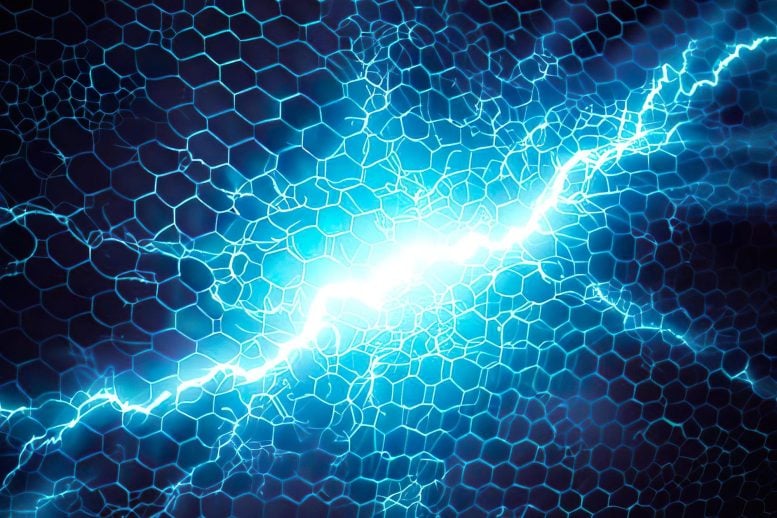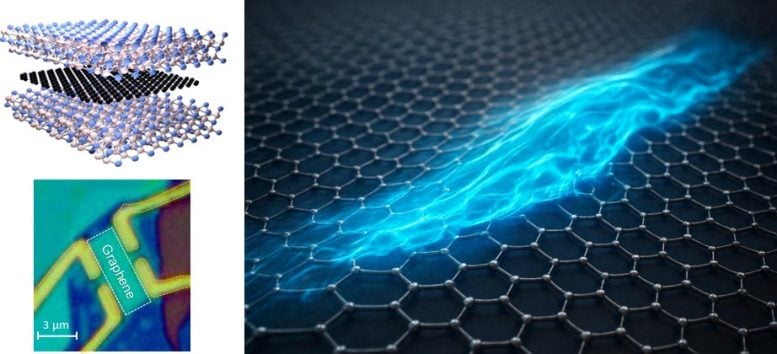
Electrons in graphene can act like a perfect fluid, defying established physical laws. This finding advances both fundamental science and potential quantum technologies.
For decades, quantum physicists have wrestled with a fundamental question: can electrons flow like a flawless, resistance-free liquid governed by a universal quantum constant? Detecting this unusual state has proven nearly impossible in most materials, since atomic defects, impurities, and structural imperfections disrupt the effect.
Detecting quantum fluids in graphene
A team from the Department of Physics at the Indian Institute of Science (IISc), working with collaborators at Japan’s National Institute for Materials Science, has now identified this elusive electron fluid in graphene – a material composed of a single layer of carbon atoms. Their findings, reported in Nature Physics, provide a fresh pathway into quantum physics and confirm graphene’s role as a powerful platform for probing unusual quantum behavior.
“It is amazing that there is so much to do on just a single layer of graphene even after 20 years of discovery,” says Arindam Ghosh, Professor at the Department of Physics, IISc, and one of the corresponding authors of the study.

The researchers produced exceptionally clean graphene samples and monitored both electrical and thermal conduction. To their surprise, they observed that the two properties moved in opposite directions: when electrical conductivity rose, thermal conductivity fell, and vice versa. This unexpected result revealed a striking departure from the Wiedemann-Franz law, a well-known rule in metal physics that states the two conductivities should be directly proportional.
In their graphene samples, the IISc team observed a strong deviation from this law by a factor of more than 200 at low temperatures, demonstrating the decoupling of charge and heat conduction mechanisms. This decoupling, however, is not a random event – it turns out that both charge and heat conduction in this case rely on a material-independent universal constant which is equal to the quantum of conductance, a fundamental value related to the movement of electrons.
Dirac fluid and exotic states of matter
This exotic behaviour emerges at the “Dirac point,” a precise electronic tipping point – achieved by tweaking the number of electrons in the material – where graphene is neither a metal nor an insulator. In this state, electrons cease to act as individual particles and instead move together the way a liquid does, just like water but a hundred times less viscous.

“Since this water-like behavior is found near the Dirac point, it is called a Dirac fluid – an exotic state of matter which mimics the quark-gluon plasma, a soup of highly energetic subatomic particles observed in particle accelerators at CERN,” says Aniket Majumdar, first author and PhD student at the Department of Physics. The team additionally measured the viscosity of this Dirac fluid and found it to be minimally viscous, the closest possible to a perfect fluid.
The findings establish graphene as an ideal low-cost platform for investigating concepts from high-energy physics and astrophysics, such as black-hole thermodynamics and entanglement entropy scaling, in a laboratory setting.
From a technological perspective, the presence of Dirac fluid in graphene also holds significant potential for use in quantum sensors capable of amplifying very weak electrical signals and detecting extremely weak magnetic fields.
Reference: “Universality in quantum critical flow of charge and heat in ultraclean graphene” by Aniket Majumdar, Nisarg Chadha, Pritam Pal, Akash Gugnani, Bhaskar Ghawri, Kenji Watanabe, Takashi Taniguchi, Subroto Mukerjee and Arindam Ghosh, 13 August 2025, Nature Physics.
DOI: 10.1038/s41567-025-02972-z
Never miss a breakthrough: Join the SciTechDaily newsletter.
15 Comments
Maybe, if they can be violated, they weren’t laws in the first place.
Ever earned yourself a traffic citation? Laws are broken, they evolve, and are broken again. Remember when ‘nothing’ could exceed the speed of light?
Belief systems at work/play again.
In what sense? They saw a typical pattern, but this break that pattern, substantially. That’s the real headline. STD is so full of clickbait, but don’t let that distract from the actual interesting science they report.
The number of laws that describe physical reality can be counted on one hand. Okay, make that two hands. Therefore, which of the few laws that exist in nature are being violated here? I’m kinda wanting to call this click bait but the observation that the physicists made was kinda cool…
They’ve known this! Ask yourself why its incorporated in so many things, like receipts at stores and vaccines! CERN and the people that run it are not our friends.
The term “law” in the title is 100% misleading/clickbait. As it’s really a break in “typical assumptions”. STD is always clickbait-y, that’s one of the things I like a lot STD lol
Graphene electrons play exactly according to the laws of physics.
I don’t believe so I’m living proof of this! Research me p.s. I also cared for the late PHD Thomas Higgins Sr.
Tariffs on Chinese goods made this happen.
I think this is a joke? If it’s not? Lol …
This is a breakthrough discovery, though I question their priorities that they’re exploring properties of exotic materials insteas of focusing on more immediate issues like open defecation and ocean fecal contamination
What are you even talking about? There are 10x more interesting and important discussions to be had than people crapping in the wrong places.
10 09 1155 am should be a decent earthquake in La or in Alaska maybe it could jump to Guatemala ? It’s like Hop Scotch
A fluid cannot mimic a plasma state of matter. There is little to no validity to “quantum critical points” and “quantum criticality.” These concepts do not translate to the actual transport behavior and its physical basis/explanation in a real material, including graphene, strange metals or heavy fermion materials. The creation of this concept and linkage to black hole physics is meta-physics, or just plain bad physics. These materials are not a “testbed” or analogue system for astrophysical objects.